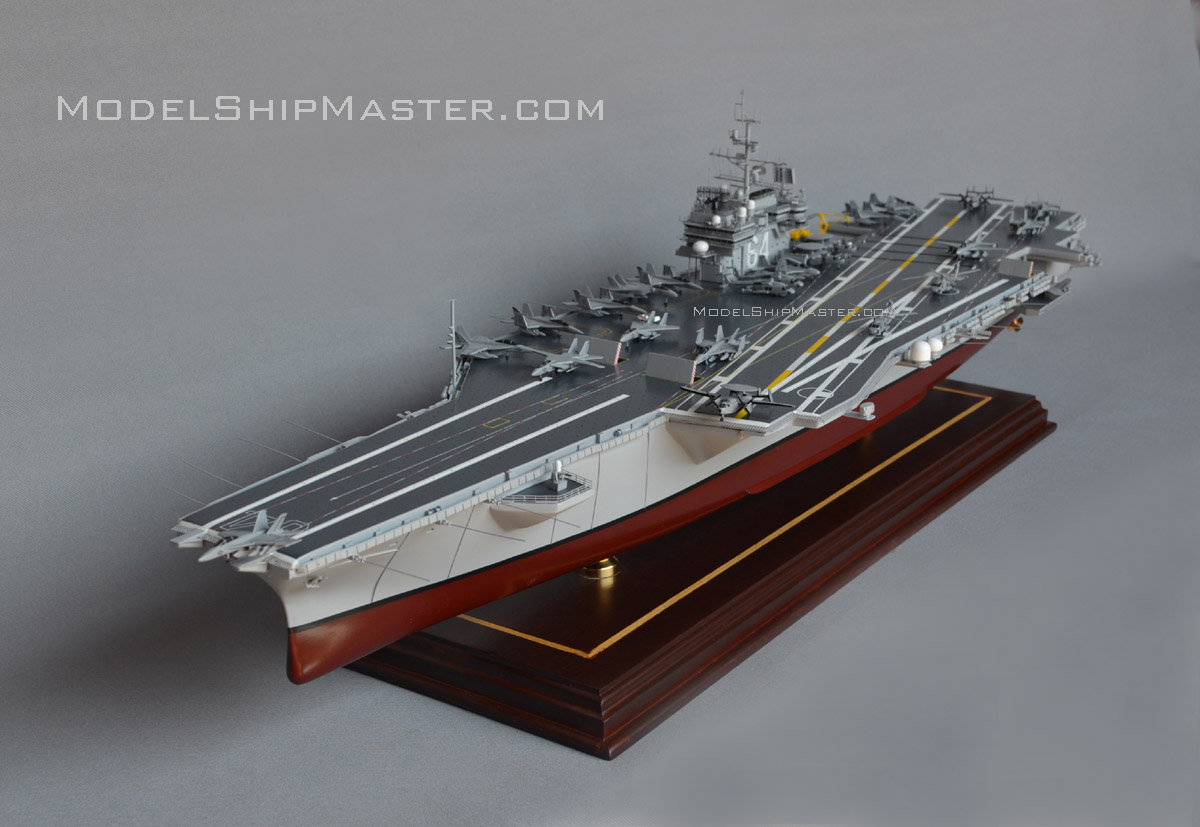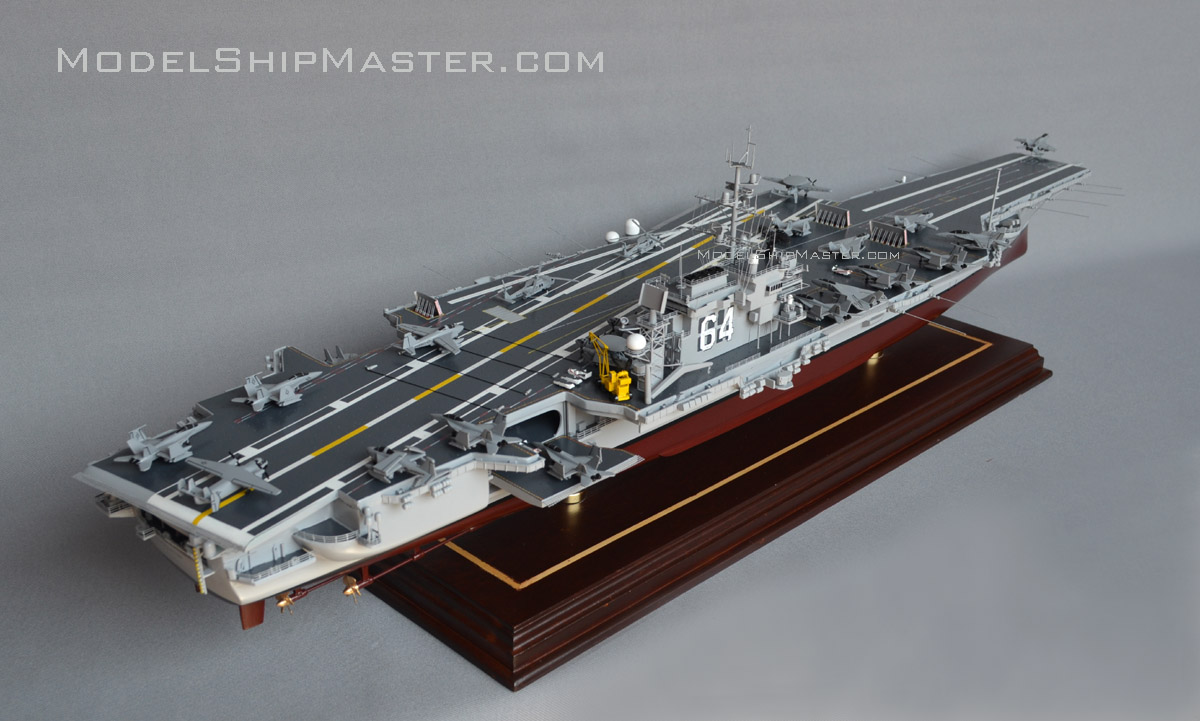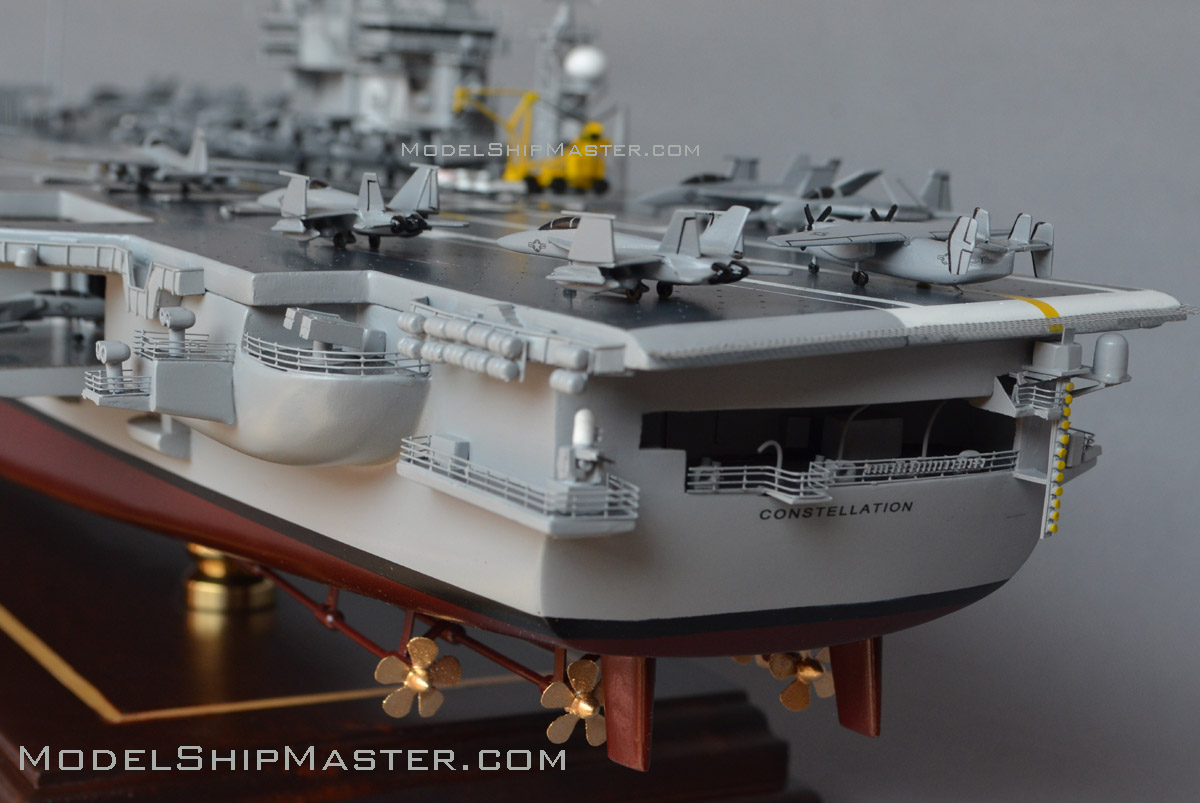|
USS CONSTELLATION aircraft carrier model
USS
Constellation is a Kitty Hawk class aircraft carrier.
She was delivered to the Navy 1 October 1961, and
commissioned on 27 October 1961. The aircraft
carrier saw plenty of action in her 42 years of
service.

The
aircraft carrier Constellation's second deployment began
in May 1964. On August 5, USS Constellation and USS
Ticonderoga launched 60 sorties against four enemy bases and their
supporting oil storage facilities. Those attacks
resulted in the destruction of 25 PT-type
boats, severe damage to the bases, and complete
razing of the oil storage depot. The strikes lasted for
four hours. Constellation lost an A-1H Skyraider, whose
pilot, Lt. j.g. Richard A. Sather, became the first Navy
pilot to be killed in Vietnam, and an A-4E Skyhawk,
flown by Lt. j.g. Everett Alvarez who became the first
Navy POW.
In May,
1966, a F-4B aboard the Constellation shot
down a MiG-17 fighter jet on July 13, marking the ship’s
first MiG kill of the war.
CV-64 made
her third deployment to Vietnam in 1967. The eight-month
deployment lost 16 aircraft.
The USS
Constellation aircraft carrier began her fourth
deployment on May 29, 1968. After
flying more than 11,000 missions and dropping almost
20,000 tons of ordnance, 15 aircraft didn't return.
Constellation started her fifth deployment in August, 1969. A major milestone
happened when a F-4J marked the carrier's 100,000th landing.
On October
1, 1971, USS Constellation departed San Diego to begin
her sixth combat deployment. In this period,
TF-77 flew 423 strike sorties employing all-weather A-6A
systems backed up by A-7Es as pathfinders. The Laser
Guided Bomb was first used.

On Jan.
19, 1972, the VF-96 F-4 Phantom scored a kill against a MiG-21. This accounted for the Navy's 33rd MiG.
May 10,
1972 was the most intensified air-to-air combat day of
the entire war. Navy flyers shot down eight MiGs. An F-4
Phantom II from VF-96 on board Constellation, while engaged in aerial combat over
Haiphong shot down three MiGs for the first triple
downing of enemy MiGs by one plane during the war. These
three MiG downings, coupled with their Jan. 19 and May 8
downing of two MiGs, made Lt. Cunningham and Lt.
Driscoll the first MiG aces of the Vietnam War. The nine-month deployment ended on July 1, the carrier
having spent 154 days off Vietnam. Seven aircraft were
lost.
On January
5, 1973, USS Constellation aircraft carrier began her
seventh deployment to Vietnam. The Vietnam cease-fire,
announced on Jan. 23 went into effect on the 27th.
Aircraft from Connie flew strikes against
targets in southern Laos. These combat support
sorties were flown in support of the Laotian government
which had requested this assistance and it had no
relationship with the cease-fire.

On January
31, 1975, CVA 64 departed San Diego for the
Puget Sound Naval Shipyard to undergo
on of the most extensive carrier overhauls ever
undertaken, enabling her to carry the Navy's newest air
supremacy fighter, the F-14A Tomcat, and the S-3A
Viking--a submarine hunter.
In
December 1982, CV 64 again sailed north to Puget Sound
Naval Shipyard in Bremerton, Wash., to begin a 14-month
complex overhaul. She was modified
to carry the Navy's newest strike fighter, the FA-18
Hornet. Connie was the first carrier to receive the new
aircraft. She was also fitted with the new Phalanx
radar-guided gattling-gun, two new flush deck catapults
and the NATO Sea Sparrow Missile System.
On July
31, 1994, Lt. Kara Hultgreen made her first qualifying
landing in an F-14A on board the Constellation, 110
miles southwest of San Diego. She thus became the first
fully qualified female Tomcat pilot.


USS Constellation entered the Persian Gulf on Aug. 28.
In 10 weeks she conducted more than 5,000 sorties and
1,256 OSW sorties, and expended nearly 44 tons of
ordnance during nine combat engagements against Iraqi
targets. The Carrier Air wing Two aircraft flew more
than 1,500 sorties and expended more than 1 million
pounds of ordnance, including 408 Tomahawk cruise
missiles.
August 7
2014, after nearly 42 years of service and 21 completed
deployments, USS Constellation was decommissioned in a
ceremony held at Naval Air Station North Island, San
Diego.

This primarily wood USS Constellation aircraft
carrier model
is one of our fifth-generation models is 37" long $3,990  Shipping and insurance in
the contiguous USA included.
Other places: $350 flat rate. This model is
in stock and can be shipped within five business
days. Shipping and insurance in
the contiguous USA included.
Other places: $350 flat rate. This model is
in stock and can be shipped within five business
days.
For larger sizes, email us for a quote. ModelShipMaster.com
is the only one who can build massive models, as much as
the door of a full size truck can accommodate. Click here to
learn more:
very large ships.
If you want other aircraft carriers of the Kitty Hawk class,
just let us know. Kitty Hawk CV-63, America CV-66, and John F. Kenedy
CV-67.
Learn more about the
USS Constellation here:
https://en.wikipedia.org/wiki/USS_Constellation_(CV-64)
|